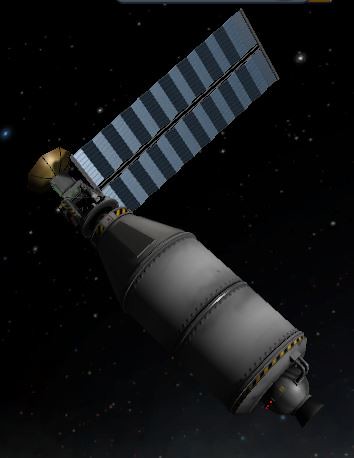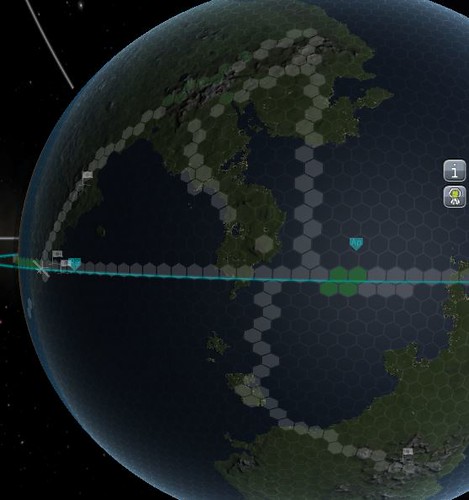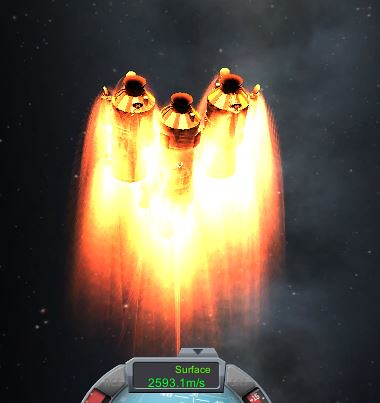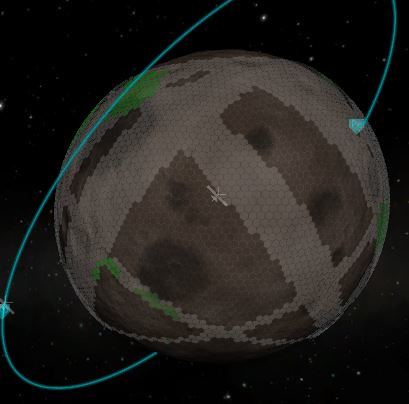KSP boredom
Kerbal Space Program - henceforth KSP - is a rocketry simulation game with fictional planets to visit and explore. ('Nasa simulation' over-connotes management aspects that are currently absent from the beta.) I found it through youtube recommendations posted of uncuccessful attempts and then following its two rockstars: Scott Manly and HOCgaming. My curiosity grew beyond passive viewing and I purchased a copy.
Here began a whirlwind romance that, to date, I have let consume 175 hours of my life since July. That number is somewhat deceptive. Perhaps 15-25 of those were unsupervised autopilot, whilest I ate a meal downstairs. (We can design and control air/space planes or rovers as well.) Nevertheless, this has engaged me the longest of any other. The likely runner up is King Arthur's Gold, by dint of similar inactive (but not afk) playtime. In that case, I often watched in five minute increments, after an early death, as the other players hunkered in separate tombs rather than clear the zombie infested spawn point.
Had I finished this post last month, it would have been a narrative acount of my progress. This would have been an image studded post, showcasing the evolution of the rocket designs I employed.
 Woo here's my first successful satellite.
Woo here's my first successful satellite.
 Woo here's my first plane's route. Etc.
Woo here's my first plane's route. Etc.
Hello, I'm glad you've decided to visit the official KSP museum-website. I'm sure you have seen the launches in the papers and wondered where you could find out more about becoming an astronaut or the vessels already roving our interplanetary frontiers. Well, the directors had waited until they had some successes under their belt before approving any budget for any documentary efforts. Well, I'm glad they remembered posterity at all. In the excitement of leaving the cradle, many don't and the baby steps are lost. (Unlike our parents whose strong obsession wanes and is bullied into dormancy as their charges age.)
 Cool reentry bro. // Rest of the uploaded photos.
Cool reentry bro. // Rest of the uploaded photos.
Engrossing, I'll bet; not unlike looking at pictures of other people's children. In that month, though, the first element of Career_Mode dropped and mussed up my assessment of meaningful action. Before the .22 update, the game only offered sandbox mode. The distinction is much like between Minecraft's Creative and Survival modes. Creative/Sandbox offers every part and no externally imposed challenge at all. Survival/Career restrict one's initial tools severely and place challenges in the way of getting them. In KSP, this means unlocking parts by measuring conditions with sensors in various places on one's home planet - Kerbin - and the other celestial bodies.
Much like Minecraft, the unrestricted version inspired some players to take the crayons to the limit. I have seen videos of rocket powered owls and amusement park rides. Unlike creative mode, getting skilled in basic mechanics was quite time consuming. I wish I had kept a timeline of my progress. Soon after I began (.20), Squad - the development team - released a save-file breaking update (.21) that began to log when players accomplished landfall, orbit or flyby of all the planetoids.
Eventually, achieving orbit became managable and another problem loomed: reaching the other bodies. KSP's maneuver node system projects how a craft's orbit/path will change with certain burn times and angles. One can thereby see what it would take to reach Kerbin's moons or any other object. But, I often only found the capture angles by blind trial and error. Instructions I didn't look at until later specify that when a particular part<> of one's orbit touches the orbit of another object, KSP will show the relative positions of each at the closest approach.
 Dotted path is the projection
Dotted path is the projection
Ignorant of this, I downloaded the plugin "Protractor" to show me where to aim for a planetary encounter. This helped some, but reinforced that I needed to drop my stubborn insistence on exploring outward at my whim, rather than at the least expensive time to do so. I still would like to use or make an Orrery type<> plugin, but won't have an opportunity for the forseeable future.
Other plugins caught my eye: Chatterer, to hear Apollo/Soyuz recordings in flight; Alarm clock - intensely useful in a game with fast forwarding; and the Kethane mod. Majiir created the plugin/parts to allow players to drill and refuel their craft without cheating. I most appreciated the surveying equipment. His mod will show a sphere wrapped outside the planet with hexes marked showing which areas have been surveyed and, of those, where kethane lies. (Which is how I logged the airplane path above.)
This imbued my goals with renewed purpose. There is an obvious impetus to get a craft to every location. But, now I could map them. Planting flags everywhere is cool, but making something beautiful is better. So, I lifted seven craft with sensors in time for the proper transfer windows and shot them off.
Luckily, they had varying arrival times. Though I didn't realize it, the pattern is the same for every destination. Launch, eject at target, midway course correction, capture correction, and orbit correction. Planets with atmospheres are hardest because I gave in to the temptation to save fuel by aerobraking. Unfortunately, finding the right depth without flying past or crashing down is tedious. As they started to arrive though, the update came and interrupted the capture dance. This was quite fortunate because waiting for the kethane map to develop takes many minutes depending upon the orbit altitude and whether the craft runs out of electricity on the night side of its journey.
The tech tree restriction could not have come at a better time. I had a wretched time of landing craft on Minimus (Kerbin's second moon) the first time around. Practicing multiple times tightened that right up. Further, my craft are much better focused than before. In the sandbox, unless I was delivering an astronaut to the surface, a craft was essentially fuel tanks and a battery. After I installed kethane, every ship had a sensor. (I even tried to cheat them into craft already in orbit - bad, bad choice.) Now, each has the job of taking a variety of science sensors and transmission equipment to relay the results and unlock more parts.
There's more narrative available, were I to relay my progress in the updated campaign. The documentation is much more thorough. But, honestly, I have reached the end. I hadn't played at all this last week. Partly, because I felt dissonance over which I ought to log into. 'Should I complete all the kethane maps or make new maps in the science mode?' Partly, because waiting for the map to form is boring. And, mostly, because this game takes so long.
Today, I decided that I'd turn it on to get one or two pictures to complete this article, and maybe end the sandbox campaign. I did both, but the latter took five or so hours. And now I have a satellite in each system. Few are well mapped at this point, but that doesn't bother me. Now that I've seen them all, getting there with Kerbals isn't so enticing. Perhaps in a month, I will have detoxed enough to want another run. For the moment though, I've had my fill. Game over: final boss defeated, bronze medals all around.
Understand, though, I'm not saying that I dislike Kerbal Space Program. I have probably ground out more escapism from this than any other purchase except the computer that I'm currently using. I am quite pleased that enough gamers supported Squad long enough that they have pushed the game to its current state. There were versions released without maneuver nodes, without flag planting, and without a tech tree. But, I have simply had my fill and don't feel any completionist drive. I never built a castle in minecraft. My mines were plenty big, to find enough diamond to make at least a pick. But setting up a fake base that will always be deserted holds no appeal.
